3
Recycling, reuse and the circular economy
Overview
A circular economy is defined by the Ellen MacArthur Foundation thus:
In the built environment, an analysis of the carbon impacts of reuse and recycling in comparison to the use of new material helps to quantify the benefits of circular economic thinking. A fundamental principle of a low carbon, circular economy should be to maximise beneficial recycling wherever possible. Circularity has two principle low carbon benefits: firstly, reducing waste; secondly, reducing the need for new materials.
Recycling can occur at any scale, from reuse of entire structures and buildings (as in refurbishment or retrofit projects) through reuse of systems to recycling individual components or materials. The ideal is for a recycled item to be reused at the highest possible level. A brick can be reused as a brick, which removes the need to make a new brick, or it can become ballast in a foundation, where its carbon value is lower. Continuing with the brick example, very strong mortar is all but impossible to remove from bricks, whereas a softer mortar makes them relatively easy to reuse. This illustrates the importance of forward thinking to end of life at the design stage. Recycling is a two-way thought process: not only should we be designing to use the maximum recycled material, we should also be doing so in such a way as to enable future recycling of our buildings whole or as components with minimum waste and use of energy.
A traditional linear economy involves sourcing new raw material, making it into products, using those products, and then treating the redundant products as waste. This is profligate, inefficient and unsustainable in the long term. Far better is for a waste product to be reused to form a new product using a minimum of new material and energy. Confusingly, it is possible to use recycled material and still increase the carbon footprint of a building. This occurs where, for example, recycled materials are transported long distances, or where energy-intensive reworking of waste material is required. It is therefore essential when considering the use of recycled material to achieve a full understanding and quantification of its sourcing, fabrication, delivery and ultimate disposal.

Figure 3.01: Circular economy concept.
Reuse and existing buildings
With respect to the built environment, the optimum is to reuse as much existing structure and material as possible, preferably without the carbon costs of dismantling and relocation. This was previously known by the unappealing title of refurbishment, but is now called retrofit. Retrofit involves updating existing systems with new, performance-enhancing additions; used in relation to buildings, it implies a refurbishment that has an additional ‘green’ tinge, including energy-efficient and/or low carbon measures that are over and above the basic Building Regulations requirements.
The vast majority of building work in the UK involves the reuse of existing buildings. The retained embodied carbon (ie emissions already released through earlier construction activity) avoids the need for new equivalent construction. Retention and refurbishment of existing buildings has many benefits compared to equivalent new build, including cost of construction, programme to delivery, and often localism and social benefits. The problem is that where there is a choice, refurbishment/retrofit is often perceived as the less desirable option from both environmental and commercial perspectives. It is not unusual for the case for demolishing and replacing existing older buildings to include the claim that they are poor environmental performers and, in emissions terms, better replaced with new. Case study 3 suggests that this is not necessarily true.
The 2012 abolition of VAT relief on listed buildings, and the fact that VAT is generally applied at the standard rate to retrofit (compared to zero-rated new build) further disadvantages the potential for retaining and recycling older buildings. In general, the carbon, environmental and long-term economic value of existing structure and fabric is not properly considered. From an environmental performance perspective, existing buildings are usually judged solely on their operational carbon emissions costs, and in direct comparison with an equivalent new build the retrofit will typically not perform as well.
However, taking a whole life carbon emissions approach, where both operational and embodied carbon emissions costs are assessed, you get a different picture. Case study 3 illustrates the carbon benefits of a high-quality retrofit in comparison to an equivalent high-performance new build to Passivhaus standards. In this example, the retrofit performs better in whole life carbon terms due to the retained embodied carbon.
The opportunities for retrofit are restricted when it comes to listed buildings or conservation areas. This is due to understandable concern about the impact of retrofit measures on the historic nature of the fabric, and the potential for damage due to poorly thought-through insulation, airtightness, etc. However, the long-term social and economic value of such properties – on which their ultimate existence relies – suggests that maintaining the status quo is not an option. To ensure their continued value to society, methods must be developed to ensure listed buildings get closer to current new-build environmental standards. The National Trust for England and Wales has committed to reducing its dependence on fossil fuels by 50% by 2020, and the National Trust for Scotland likewise 45% by 2020. The action of these leading heritage organisations suggests that there is scope to improve the operational performance of even the most sensitive historic buildings. Case study 4 examines the whole life carbon emissions impacts of different standards of retrofit. This case study shows that, despite their associated embodied costs, additional physical measures provide worthwhile operational and whole life carbon benefits.
Case studies 3 and 4 suggest that UK government policy aimed at reducing carbon emissions in the built environment should be strongly geared to encouraging retrofit, and to the highest standards. If we are to move towards a circular economy, then we need to start with improving how we reuse existing buildings. This has long-term economic and environmental benefits. However, it would require the VAT regime for retrofit to be brought into line with new build, and, in the case of listed buildings, methods must be developed to enable significant improvement in their environmental performance.
It is worth noting that whole life carbon analysis combined with life cycle analysis can greatly improve our understanding of the environmental and financial impacts of various retrofit strategies. (See also the sections on carbon cost analysis and MAC curves in Chapter 6.)
Future circularity
The quest for a truly zero carbon future has focused thinking on how buildings are made, where they come from and how they are disposed of. It is said that in nature there is no waste – in other words, there is total resource-efficiency. The current cycle of making, using and disposing of buildings is entirely counter to this principle. If we are to move on to a truly zero carbon trajectory for the life of buildings, then we must change the way we make them, and optimise the use of recycled material as a matter of course. We must think of a building as an evolving process rather than a box that is ‘finished’ at a fixed point in time.
Future low carbon buildings will be made of components that are close to 100% recyclable either directly by reusing them as is, or indirectly – as my colleague Dr Qian Li says, ‘Use what you have to make what you will have.’ Architects and engineers will, from the outset, have to design with consideration for the future life of materials and components and not just in response to their immediate brief. Waste from everyday consumables will be used both to manufacture building materials and to power the fabrication process. Total flexibility will be fundamental: buildings will be capable of being changed, dismantled, moved and reassembled with the minimum addition of new resources and energy. This is essentially an updated version of the 1970s concept coined by former president of the RIBA, Sir Alex Gordon: ‘Long life, loose fit, low energy.’2
However, the buildings resulting from this particular approach were typically products of a linear economy, and produced the waste associated with such fabrication processes. Taking a more circular approach, the ideal is to both design with reuse and design for reuse. The additional development of nonlinear processes (eg 3D printing and self-assembly) will potentially deliver both resource optimisation and zero waste, and will directly reduce the carbon emissions cost of making buildings.
Reuse of resources is not a new concept. Making buildings out of redundant material or trash, while not routine, is certainly not unheard of. Typically, though, such buildings or constructions have been associated with alternative living, ie not seen as mainstream or commercially viable. Recycling of basic materials is, however, much more widespread, occurring in a large range of construction materials such as steel, aluminium, concrete (cement replacements) and so on. What is rarer is the idea of designing buildings to be capable of total reuse without waste or complex reworking.
A feature of the circular economy as applied to buildings is the idea of them being inherently flexible and reusable, not just as a whole but as a collection of materials. For any organisation occupying a building, there is almost always the need to adapt even the most carefully bespoke building to meet changing circumstances. Our current approach to change typically entails destruction followed by new construction, whether it is through alterations to interior layout or the creation of additional space. A building can be seen as an assembly of materials and systems that need to be capable of random and easy change. For many large organisations, change is inevitable but is usually seen as an irritant and a necessary evil. If changes were easier, less wasteful, and inherently democratic, this could well turn building change from a negative to a positive. This would require bringing together some of the above ideas, and enabling people to drive change themselves. To do this, we need to harness the collective intelligence of the building users. A simple illustration of human/product interface is artificial intelligence beer: this beer responds to consumers through social media to change its ingredients and improve its taste.
A similar example of the power of collective thought is the termite mound. Termites individually know very little, but collectively they design and build termite mounds that ensure that the queen located in the centre is kept at a precise temperature. They do this by using their own version of 3D printing (sand mixed with saliva) to collectively produce mounds with highly sophisticated passive cooling, heat rejection and ventilation systems.
Could the collective intelligence of humans be channelled into improving and adapting their immediate environment? Google recently bought the British company DeepMind, which specialises in the human/AI interface. Linking this concept with digital mapping, designing for reuse, 3D printing, etc might enable buildings that could be designed by the occupants. A simple example of this would be to monitor individual tolerance to temperature over a whole group within a room, with the temperature adjusted by the average requirement. If the activity within the room changed from passive to active, the room temperature would change to meet the new circumstances. In fact, Google already markets an intelligent temperature control product called Nest. Nest learns the occupier’s behaviour, even automatically turning down the temperature when the house is empty. This of course helps reduce energy wastage.
Imagine if the requirement were changed from temperature to the need for a new meeting room and add in reuse of materials, etc. The following diagrams show the carbon activity of creating a new space. The first shows the current energy and material transaction associated with making a new room: the old and new are entirely separate, with the old being 100% waste. The proposed energy and material transaction shows the new being fabricated using the old, with the process powered by food and other material waste. The final diagram shows the carbon activity associated with making a new meeting room using redundant material from a building or group of buildings large enough to support this process.
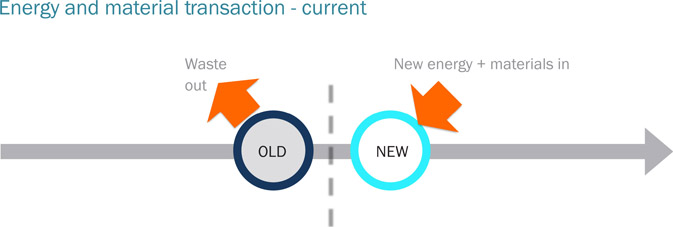
Figure 3.02: This diagram represents a normal building alteration, with the old becoming all waste, and the new is from entirely new resources. There is no connection between the two.
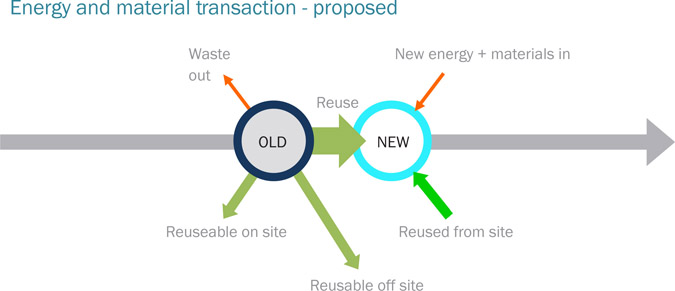
Figure 3.03: This diagram is the most ‘circular’ approach with resources managed to reduce waste and optimise reuse.
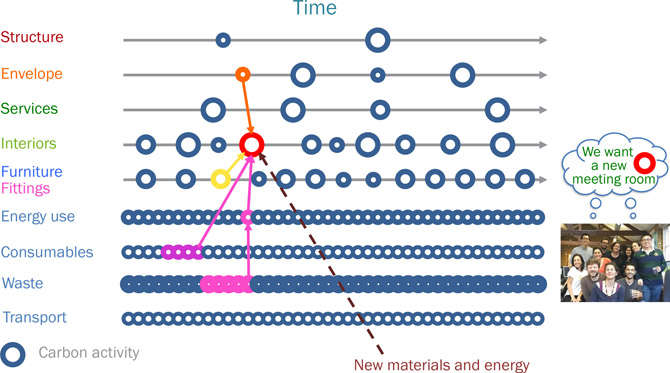
Figure 3.04: Carbon map illustrating the possible sources of energy and materials required to create a new space.
This approach requires tracking and mobilising all material-related data within a building or group of buildings and using this as a conduit to facilitate and optimise change. This is likely to be a future, active version of BIM that interacts with AI, digital space mapping and localised product manufacture. Aggregating the previous diagram produces the following conceptual carbon activity matrix:

Figure 3.05: Carbon activity map – recycling from within. Extrapolating from 3.04, this shows how energy and materials might flow around a large building or group of buildings over time.
This illustrates the idea of the building as an organism that undertakes change in response to occupier requirements. It feeds off itself, ie redundant material, waste from food and other consumables, and also from surrounding buildings. It is potentially a highly resource-efficient process. And while I have suggested that this ultra-low carbon future is the product of sophisticated technology, the above diagram could just as well apply to a group of buildings built entirely from timber. The essence is the ability to reuse and interchange objects in response to user requirements without waste and with the minimum of CO2e emissions.
Waste material from day-to-day building use can be used to make building components, or to provide the energy to do so. The quantity of waste material that western societies produce is truly phenomenal. A large proportion already goes to recycling depots for reuse, although often to be used at a lower level. Much goes to power generation. The ideal is to pre-empt this process by enabling localised energy generation and even production.
The circular economy principle is also inherent in rethinking procurement to optimise reuse and improve market incentives. An example of this is an area of new lighting at Schiphol Airport in Amsterdam. The traditional route would involve employing an MEP engineer to lay out and specify the lighting requirements. This is then tendered by the supply chain where the incentive is to produce the cheapest light fitting to win the job. The circular approach is to ‘buy light’ rather than light fittings. The supply chain is asked to tender to provide an illumination level for a given period, say 20 years. The tenderer is incentivised to choose the minimum number of fittings to achieve this and, as he or she retains ownership of the fittings, to also provide a more durable fitting to increase life expectancy and minimise replacement, and one that has value when no longer required. Additionally, fewer maintenance visits equals less fuel use. Anglian Water is another innovator in this area, believing that reducing carbon costs also reduces financial costs. For example, Anglian Water now asks the supply chain to ‘move water’ rather than to provide a pre-determined pumping building. This encourages innovation and reduces procurement costs.
Building designers need to be made aware of the importance of carbon reduction, and to adjust working practices and methods to facilitate it. Material selection, project detailing/structural calculations, and thinking long-term past practical completion can all aid dismantling, recycling and reuse, and reduce carbon emissions.
Are today’s building designers equipped to design zero carbon buildings? The basic processes for truly zero carbon assembly, enabling 100% reuse and using predominantly recycled material, will be highly sophisticated. Advanced product designers and intelligent software may be required to track and manage large amounts of materials data. Efficiencies of scale, as in city-wide material trading, will be needed. The internet can obviously facilitate this; however, the demand for recycled material as opposed to new is not yet a fully economic proposition in a number of cases. Work being carried out with Grosvenor, which owns more than 6,000 properties in London, suggests that even where there is the will to recycle, tracking and valuing reusable materials (bricks, timber, aggregate, etc) for potential reuse is a major challenge, and is often more expensive than buying new.
Real and imagined cost concerns as well as the potential unpredictability of supply are undoubtedly major impediments to recycling and the circular economic principle with respect to design and construction. But this can be changed. On several campus-type projects (eg Gatwick, Warwick University) involving large numbers of buildings that are prone to change and churn, the idea of buildings designed from the outset to be capable of easy change, extension, reuse and relocation to meet different demands is being actively considered. With the aid of ‘big data’ tracking, this will enable the next generation of buildings to be made from the current with known cost, supply and risk profiles (see case study 5: Circularity in practice – relocating a 3500m2 building). Using the internet to bring supply and demand much closer together will help facilitate this kind of approach at the city-wide scale.
Demand for recycled materials and products needs to start with clients, investors and occupiers. This will only happen with increased awareness of the benefits, reduced risk and a clear need for lower whole life carbon buildings. For designers, contractors and the supply chain, education is also necessary to bring about increased understanding of recycling and the circular economy concept.
Carbon benefits of retrofit vs new build
This case study, undertaken in 2013, looks at the carbon benefits of recycling whole buildings in comparison to the highest environmental quality new build, and is based on project work done for Grosvenor in London.3 Specifically, it compares three residential scenarios over a 60-year period, as follows:

Figure 3.06: Residential scenarios over a 60-year period, see below.
Scenario A
The baseline is a two-storey, 19th-century, brick terraced house with a slate pitched roof and a flat roof extension to the rear – typical of much urban housing in Britain. No work beyond basic maintenance and decoration is assumed.
Scenario B
Retrofit of the baseline building is the second option. This takes a comprehensive, ‘fabric first’ approach to improving building envelope and the operational performance, while maintaining the vapour permeability of the original construction. The house is in a conservation area, ruling out measures such as external wall insulation to the rear of the property, but solar photovoltaic panels (PVs), airtightness and mechanical ventilation heat recovery are proposed.
Scenario C
The last option is the replacement of the existing building with an exemplar new building. The house is insulated to the Passivhaus standard and is zero carbon, as defined by the UK government’s 2016 target for new homes (all regulated operational carbon is offset by 25m2 solar PVs). The substructure is concrete. The frame, wall cladding and roof are all timber.
The detailed assumptions are as follows:
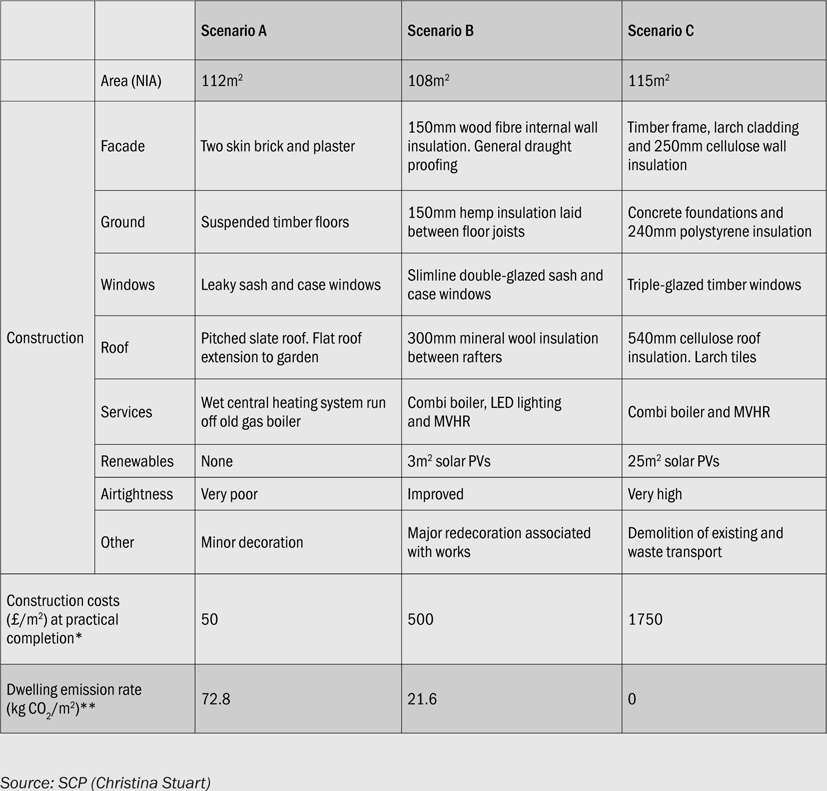
Findings
As can be seen below, there are considerable differences between the whole life carbon of the three options.
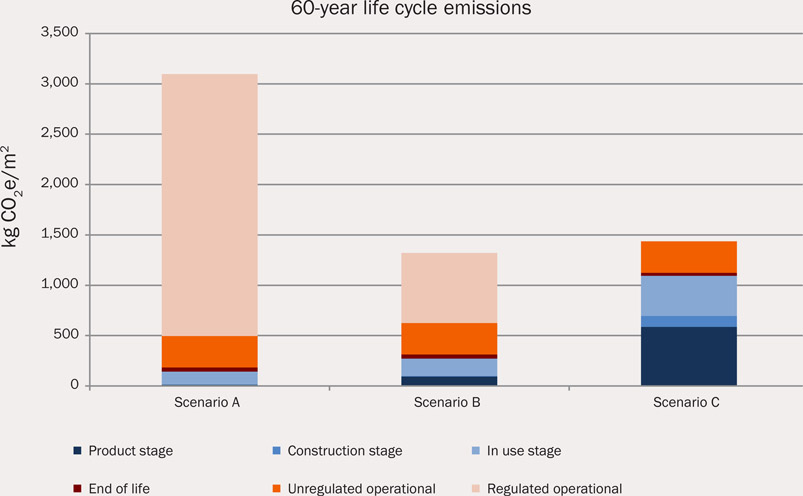
Figure 3.07:
Whole life carbon scenarios, see below.
- The baseline scenario A’s whole life carbon emissions over 60 years is double that of the other scenarios. With very little capital carbon expenditure, almost all the emissions are operational.
- Scenario B shows that it is possible to make substantial reductions in emissions through retrofit – though the operational performance is obviously still well below Passivhaus standards.
- The additional embodied carbon required for installing and maintaining the retrofit measures is less than 150kg CO2e/m2. This carbon expenditure effectively halves the whole life emissions through operational savings. This carbon return supports retrofit investment as an ‘allowable solution’ for offsetting emissions.
- The life cycle analysis suggests scenarios B and C are similar over 60 years, but the whole life costs of B are slightly better than C.
- The key difference between the retrofit and rebuild whole life carbon is the ratio of operational to embodied emissions, with the 80/20% split reversed in scenarios B and C.
- In the Passivhaus scenario, most emissions beyond practical completion are due to replacement of elements such as solar panels and cladding. This is partly because renewal of items would likely bring forward the replacement of connected elements, eg timber cladding would probably be replaced at the same time as cellulose insulation. Scenario C has significantly more PVs than B, with attendant embodied costs of replacement.
- Over the long term, the emissions of the unimproved house increase more rapidly than the other options due to its larger operational demand.
- This is also due to heavier reliance on gas, which is more efficient in the short term but less so as the grid decarbonises. It may therefore be appropriate to change the heating and hot water systems to electricity in the medium term.

Figure 3.08: Future prediction of embodied carbon scenarios.
- As shown in the diagram above, Scenario B has the lowest whole life carbon in 2050. This suggests that retrofit is the best strategy for reducing emissions by this date in order to mitigate climate change.
- As it does not benefit from retained fabric, the whole life carbon footprint of scenario C is significantly higher at practical completion, reflecting the embodied carbon in demolition, materials and all-new construction.
- The gap narrows between scenarios B and C, with the Passivhaus performing better than the retrofit after 100 years.
- However, while the materials in the new build are green, they may be less durable than traditional construction (the emissions from which have already been expended). This would warrant a higher maintenance cost over time. Alternatively, use of more durable materials (eg brick cladding) would reduce whole life maintenance carbon costs, but increase the initial carbon cost of construction.
- Low house-building rates make it likely that most houses in 2050 already exist today. Therefore, the biggest gains are to be made in improving the energy efficiency of our existing building stock. Currently fewer than 5% of solid walls have some form of insulation, in contrast to 61% of cavity walls.
Assumptions
- Sequestration – the absorption of carbon dioxide by plants and trees – is outside the scope of BS EN 15978. The benefit may have already been claimed by producers, and varies depending on factors such as tree type, growth rate, processing, and treatment of waste. The whole life carbon of scenario C would be reduced by about 11% over 60 years if sequestration was included for the timber frame.
- It was assumed that 25% of construction waste would be sent to landfill, increasing end of life carbon emissions for organic materials such as timber and cellulose insulation. This figure is attributed to the timber in the product stage, for the reasons outlined above, but if separated would increase the end of life stage, particularly for scenario C.
- Allowance was made for 92% grid decarbonisation by 2045.4 Plant efficiency is assumed to improve by 20% per replacement.
- Unregulated operational emissions from items such as cookers and televisions were kept constant across all three scenarios. These depend on occupant behaviour and efficiency of appliances, so would likely be smaller for scenario C as all the fittings would be new.
- The impact of projected climate change on demand for heating and cooling has not been included. For some of the issues involved, refer to SCP’s 2011 real estate climate change model for the RICS,5 and SCP’s Climatic Risk Toolkit for the RICS 2015.6
Conclusions
This case study highlights the importance taking a holistic, whole life view of carbon emissions, and specifically the crucial role of retrofit in the UK achieving a low carbon future. There are of course economic and social arguments for building new housing; however, the overall impact of intelligent retrofit is likely to be far more significant to the UK’s carbon footprint than improving the way we build new buildings. Going up a notch with respect to retrofit, PassivHaus EnerPhit variant will undoubtedly perform better than most new buildings from a whole life perspective, and such exemplar development should be encouraged. The only provisos would be to minimise embodied costs and consider the life cycle aspects when building to new Passivhaus standards.
Retrofit – EnerPHit v Part L
This case study is based on work done for Grosvenor on its London estate (Belgravia and Mayfair). It was initially published in Building magazine7 but has been adapted for inclusion in this book.
In 2015, following the work in case study 3, a more detailed comparative exercise of retrofitting was undertaken, specifically focusing on the Passivhaus EnerPHit standard. EnerPHit is the highest energy standard for refurbishments in the UK and is based on the German Passivhaus quality-approved certification criteria. Broadly speaking, it means that the property is virtually airtight and has high insulation levels, resulting in a very low heating demand – hence the term passive. This is achieved with limited intervention to the existing building and without excessive costs.
This case study compares three scenarios from the whole life carbon perspective:
- Scenario 1: a typical un-refurbished terrace;
- Scenario 2: a Part L-compliant retrofit;
- Scenario 3: a deep retrofit to EnerPHit standards. This has been shown with and without PVs to illustrate the impact of renewables in this case.
Building to EnerPHit standards puts additional pressure on the design team and the contractor as the requirements are specific and can be considered more demanding than standard Part L-compliant retrofit. Experience show that while this may be the initial impression, the solution lies in additional training of the project team, and ensuring that the retrofit works by the contractor are to the highest quality standard. Once the contractor is fully trained and understands what is required, experience shows that they rise to the challenge. The principal benefits of EnerPHit are low energy bills,8 improved comfort, better sound insulation, no internal condensation, improved health, and higher quality control during construction.9
Scenarios explained
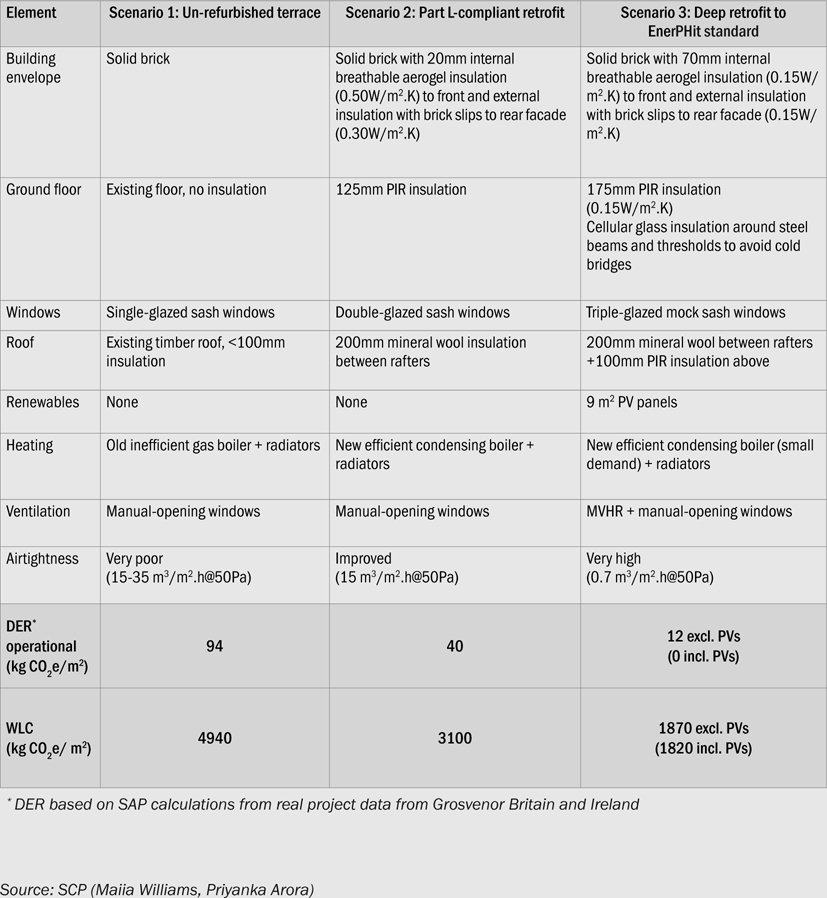
Scenario 1 DECC Average Annual Domestic Gas Bills 2014: https://www.gov.uk/government/statistical-data-sets/annual-domestic-energy-price-statistics
Scenario 2 D. Johnson, D. Farmer, M. Brooke-Peat & D. Miles-Shenton ‘Bridging the domestic building fabric performance gap’, 2014, Leeds Beckett Repository.
Scenario 3 DER based on SAP calculations from real project data from Grosvenor Britain and Ireland.
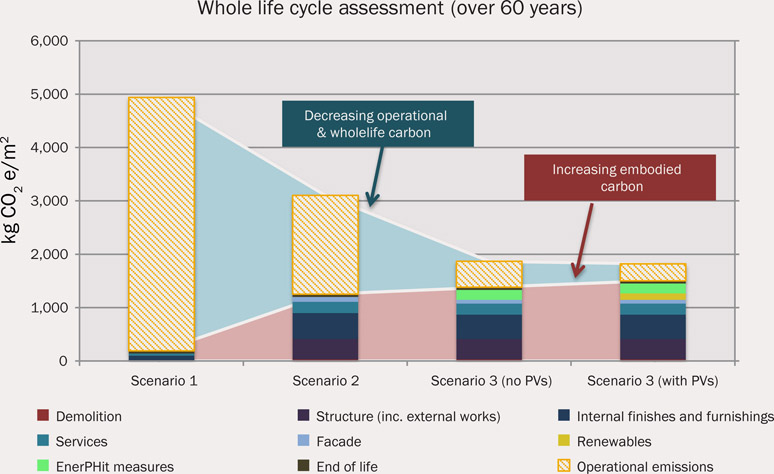
Figure 3.09: Whole life carbon assessment over 60 years.
The graph above shows considerable differences between the whole life carbon footprints of the three scenarios over 60 years. The operational emissions decrease steeply with each successive measure; however, the increase in embodied carbon after the first jump is relatively gradual.
As you would expect, scenario 2 (Part L retrofit) shows the operational energy (carbon) costs reduced by some 60% compared to that of the un-refurbished property, but at a significant embodied cost. In overall whole life carbon terms, the reduction is more like 40%.
However, scenario 3 (EnerPHit standard) shows that, for comparatively little additional embodied cost, you get a very significant additional operational saving. Compare the EnerPHit cost with the reduction in operational energy between scenarios 2 and 3. The final bar shows EnerPHit with the embodied costs and the operational energy savings of introducing PVs. This leads to a further slight improvement.
Assumptions
This study assumes no demolition waste to landfill, 50% waste recycled on site, timber sequestration excluded, grid decarbonisation allowed for, and no allowance of climate change impact on heating demand.
Conclusions
- Deep retrofit to EnerPHit standard offers better overall carbon efficiency compared to the Part L retrofit, achieving 40% whole life carbon savings. Increasing embodied carbon costs through additional insulation, providing airtightness, etc, can be justified by greater operational carbon savings.
- Thin, but expensive, internal insulation systems may be justifiable in high value or heritage buildings, whereas less expensive external systems are likely to be more appropriate for upgrading lower value properties.
- As much as 75% improvement in operational energy performance can be achieved by as little as 8% increase in insulation costs to upgrade from Part L compliance to EnerPHit standards.
- Use of photovoltaic panels to provide electricity is just about justifiable in carbon emissions terms; however, the economic benefits may be less clear.
- Experience shows that achieving EnerPHit standard upgrades to many property types, including heritage assets, is a carbon-efficient way forward.
Circularity in practice – relocating a 3500m2 building
This project, completed in 2013, demonstrates the environmental and financial benefits of circular economic thinking. The client, SEGRO, owned a 3500m2 office and warehouse that was ten years old and recently vacated in Leigh Road, Slough, England. The building was not letting, but there was a demand for a similar building 2km away in Cambridge Avenue. The initial thought had been to demolish and dispose of the original building and build a new one in Cambridge Avenue. Following initial carbon-related advice, the client decided to reduce the carbon impacts by dismantling, moving and reassembling the building in the new location. This case study is a carbon and financial comparison between the recycled building and an identical new building.
Original building
The Leigh Road building is a typical out-of-town building: concrete foundations and ground slab, steel frame with ribdeck and concrete first floor, aluminium and glass cladding, insulated metal deck roof. The two-storey office areas are standard, basic fitout, raised floors and suspended ceilings, modular light fittings and fancoil cooling system. There are stairs and a lift connecting the two office levels, with toilets on both floors.
Relocated building
The team undertook a detailed examination to see what could be economically recycled. In total, some 70% of the original material was reused, including the steel frame, the cladding, the lift, most of the services and the roof deck. Most concrete needed replacing, as did subsurface drainage and foundations, and roof finish.

Figure 3.10: Recycling buildings – relocated and completed building.
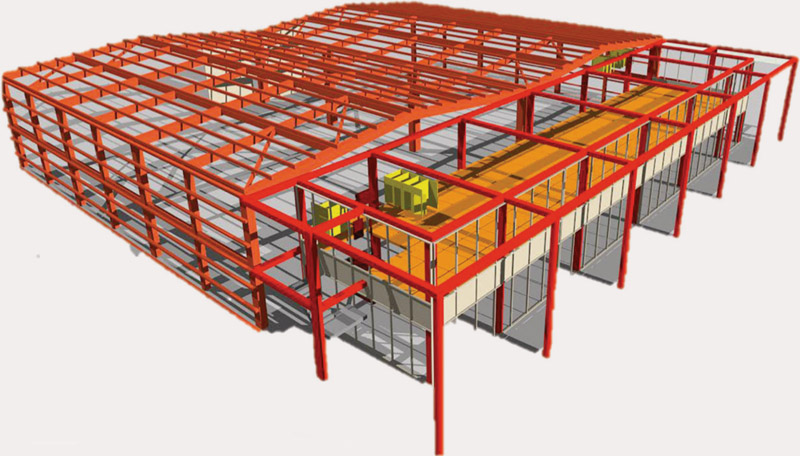
Figure 3.11: Recycling buildings – structural frame.
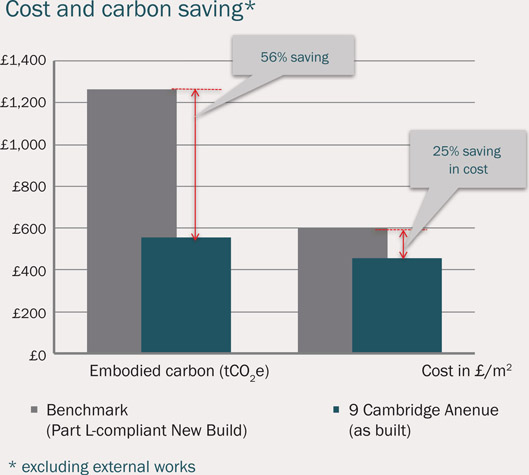
Figure 3.12:
Recycling buildings – savings.
Conclusions
As noted, 70% of material was reused, with a reduced carbon cost compared with an identical new build of some 40%. In addition, the building was 25% cheaper than a new build. The programme for either solution was about the same but, as the lift assembly was being reused, the normal long lead time did not arise. It should be noted that all of this was achieved with a building not originally designed for reuse. It can be reasonably assumed that designing a building specifically for such reuse would only improve on the above figures. The lessons learned from this case study can be applied not only to buildings such as this but also buildings that are likely to require partial change and adaptation over their life.
The building typology in this case study is typical of a large number of out-of-town uses, including retail, industrial units and many more. These are found in all countries as they are cheap and simple to build. The life expectancy is generally very short – often no more than 20 years for retail – after which the structure and fabric are typically trashed, at best for basic recycling. This involves significant energy use to refabricate the base material into new components. This cannot be the optimum use of resources. How much better it would be if the building were designed as a collection of reusable components that would have a value at the end of their initial life. Most of these buildings are effectively modular and therefore, with modest adaptation, capable of joining the circular economy.
Recycling out-of-town shopping centres
This case study is based on a 30,000m2 shopping centre in Hampshire owned by British Land. What is of interest is the life cycle over the next 60 years, and what lessons this holds for the present. The study is based on the practical lessons learned and data gathered in case study 5, and projecting into the future different commercial scenarios. The study only looks the buildings in isolation. These developments are typically very poor in terms of overall carbon footprint due to their out-of-town location and substantial car parking provision, and all that entails in both material and significant consumer fuel usage.
The new scheme consists of double-storey retail shells capable of extensive subdivision and includes landscaping and car parking. It is built to a high standard of quality and represents the forefront of a contemporary approach to sustainability, achieving BREEAM Excellent, and including PVs. The buildings consist of steel frames with in situ concrete slabs, insulated roof deck, and double- and triple-height glazing with oak-faced cladding. The subdivision walls are a stud wall system.
The developer has a detailed sustainability policy, including an environmental site management system to ISO 14001, procedures to minimise ground and surface water pollution, and measures to manage water, waste and energy use during the construction process.
This study considers three possible future scenarios for the shopping centre in whole life carbon terms. This is split into the construction phase to practical completion, and the whole life phase, which covers the initial construction and the life of the centre over the 60-year period. The whole life emissions are considered from the landlord’s point of view – i.e. excluding the tenant’s activities.

Figure 3.13:
Shopping centre scenarios.
Scenario A
This is a baseline option, and assumes continual occupation over the 60-year period. Although this may not be typical for this type of development, it does represent a norm in that it replicates the continuity of a typical high street. A refurbishment cycle has been assumed as follows at year 10 there will be a partial refurbishment and at year 20 a major refurbishment; years 30 and 50 will be as per year 10; years 40 and 60 would be the same as year 20. The structural frame, floor and ground slabs, and roof decking would always be retained.
Scenario B
This represents the more likely life cycle of a typical shopping centre – that is, full redevelopment with all new materials every 20 years (at years 20, 40 and 60). There would be a partial refurbishment or ‘refresh’ at the intermediate years 10, 30 and 50.
Scenario C
This is the same cycle as scenario B; however, it assumes that the redevelopments at years 20, 40 and 60 include a substantial proportion of onsite recycling of structural members, cladding and other materials. This would include demountable steel frame and assumes reusable concrete plank floor construction. This option also assumes offsite recycling of the unused material.
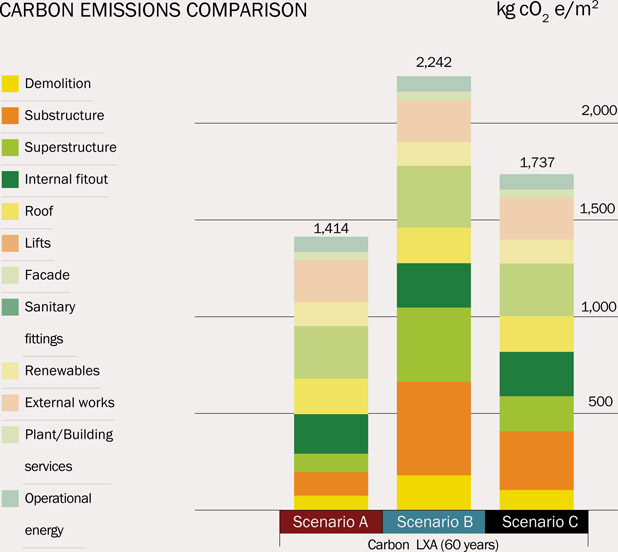
Figure 3.14:
Carbon emissions comparison.
Assumptions
- In practice the three scenarios would include many variables. These have been limited, partially for practical reasons and partially to try to isolate the key variables that make the biggest difference. For example, there is no data on the demolition of the previous scheme; however, as we have assumed this would be the same for all three scenarios, it does not make a comparative impact.
- All three scenarios are shown as having the same embodied carbon at practical completion. If you were designing for recycling this would be slightly different in practice – for example, the carbon figures for precast concrete slabs are slightly higher than for in situ slabs.
- In each scenario, it is assumed that the roof finishes, renewables and external works follow the same renewal cycles. They therefore become constants in the comparisons.
- We have also assumed that tenant fitout and churn and associated operational energy use by tenants is a constant between the scenarios.
- The key comparisons are therefore the provision of the shells by the landlord and how the projected life of these shells differs under each scenario in carbon and build cost terms.
Findings
- The overall cheapest in carbon terms is, unsurprisingly, scenario A. However, the difference between scenario A and the full demolition and rebuild in scenario B is 59%, whereas the difference between A and the recycle and rebuild in scenario C is only 23%.
- This clearly shows the carbon benefits of designing for and undertaking wholescale recycling.
- Demolition- and removal-related emissions for B are significantly greater than for A by a factor of nearly 2.5, whereas reuse reduces potential additional carbon emissions by a factor of 1.3.
- The biggest variables are in the substructure. The carbon impacts of rebuilding the substructure every 20 years are huge.
- Superstructure is similar: the whole life carbon quadruples from full retention to continual new build, but only doubles for the recycled option.
- Plant and building services emissions are only slightly greater with the continual new-build option (B) in comparison to the other two scenarios.
- The use of precast concrete slabs is very marginally worse in carbon terms than in situ slabs at practical completion; however, their whole life carbon benefits are apparent in all scenarios over the 60-year period. This is partially due to recycling benefits, and partially due to reduced demolition-related carbon impacts.
- In cost terms over the 60-year period, scenario B is unsurprisingly 54% more expensive than A, whereas the recycling option (C) is 20% cheaper than full replacement (B).
Conclusions
The most carbon-efficient approach is to build a durable building and to keep it, carrying out basic refurbishment as necessary. This suggests that not only the individual buildings should be designed for a long life but also the layout – that is, the ‘town planning’ – of shopping centres should be designed for the longer term. This implies that the buildings need to be inherently flexible and therefore less prone to commercial redundancy.
Designing for recycling, which implies future flexibility, has clear carbon benefits. It may be too much to expect that a shopping centre will remain unchanged for 60 years but if local adjustments can be achieved easily – ie through flexible construction – then the carbon impacts of such alterations will be less serious. Even if you do not propose to recycle structure on site, designing for easy deconstruction has carbon benefits. Designing for flexible deconstruction aids maintenance and refurbishment.
Wholesale replacement of buildings on a 20-year cycle (or shorter) is very expensive in both carbon and financial terms and very inefficient in terms of resources. Designing for durability, flexibility and a longer life at both the town planning and building scales should help reduce the occurrence of commercial redundancy in this type of shopping centre. Flexible, elemental construction will also help mitigate, in carbon terms, the changes that are likely to occur during a scheme’s life.
